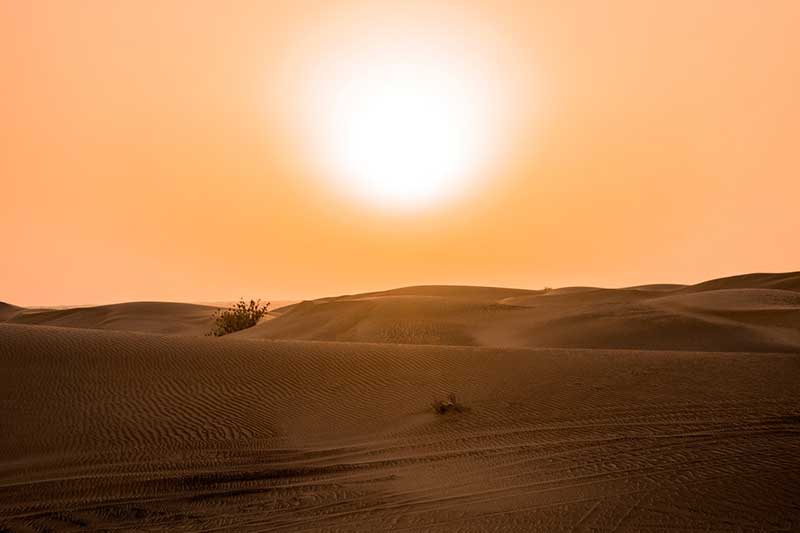No matter where you live on Earth, you and your home are more than likely at risk of suffering one or more kinds of natural disaster. Whether it be a hurricane, tornado, earthquake or other natural catastrophes, you have no doubt considered what types of weather could strike your home and affect you and your loved ones.
Disasters come in all shapes and sizes, ranging from region-spanning hurricanes and thunderstorms to more localized tornadoes and rainstorms. Whether you live in the arid Mojave, the East or West Coast, or on the Great Plains, you’re undoubtedly at risk from the effects of extreme weather. Here in this list, we go over seven types of weather that lead to natural disasters and what you can do to prepare in the event of a worst-case scenario.
What Are 7 Types Of Weather That Lead To Natural Disasters?
1.Thunderstorms

The first on this list, and one you’ve surely encountered in life, is the thunderstorm. Characterized by their lightning, thunder, high winds and heavy rainfall, thunderstorms are a global occurrence. Some of the most dangerous weather phenomena can be associated with thunderstorms: hail, extreme winds, and even tornadoes are all the result of the most powerful of thunderstorms. While thunderstorms can occur almost anywhere on earth, they happen the most often in the mid-latitude regions of the planet where hot and humid air from the Tropics meets cold air from the Arctic and Antarctic poles.
Thunderstorms, as mentioned above, tend to form when hot and humid air rapidly rises and condenses, forming clouds called cumulonimbus clouds. The water vapor then condenses into raindrops that then fall to earth, causing a downdraft of cool air that follows the rain, causing the thunderstorm’s characteristic wind and rain.
2.Tornadoes

As tornadoes go, they are one of the more dangerous types of weather. Powerful, destructive and unrelenting, tornadoes are a force of nature that should not be taken lightly. While most common in North America’s infamous ‘Tornado Alley,’ tornadoes in some form can, in fact, happen virtually anywhere on earth where there is extreme weather. Tornadoes are easily recognizable, composed of a large, rapidly rotating funnel of air, dust and debris picked up by the storm. A lesser-known variation of the tornado is called a waterspout, which forms over bodies of water.
One thing that makes tornadoes so dangerous is their sheer power. The strongest of tornadoes can attain wind speeds as high as three hundred miles per hour, and have a base as wide as two miles across. Such monster storms have been known to utterly devastate entire communities in one fell swoop by annihilating homes and businesses alike.
3.Blizzards

Similar in some ways to thunderstorms, blizzards present their own list of dangers. One of the more dangerous types of weather on this list, they are differentiated from regular snowstorms by powerful and sustained winds of thirty-five miles per hour or more for an extended period of time. Because of heavy snowing and the low visibility associated with such storms, traveling, or even just being outside during a blizzard, can be extremely dangerous. In general, blizzards form near the more polar latitudes, when hot and cold fronts meet, making them a fact of life for those living in northern states or regions.
4.Hurricanes And Cyclones

One of the most dangerous types of weather on earth, hurricanes are powerful storms that form in the tropics during the summer months. If you’ve ever lived on or near a coastline in this region or currently do, chances are you’ve experienced the effects of a hurricane in your lifetime. In some parts of the world, hurricanes are known as cyclones, especially in East Asia and the Pacific.
Both hurricanes and cyclones are characterized by their tremendous size, with some of the largest in recorded history being over a thousand miles in diameter and with wind speeds in excess of 160 miles per hour.
Such severe storms can cause equally severe damage. Entire regions can be devastated and left without power and utilities for weeks or even months in the wake of such storms. Falling trees and debris are a major hazard, as debris picked up by such high winds can result in severe injury or death if it strikes someone. Flooding caused by storm surges can also lead to a loss of life and major property damage in low-lying coastal areas.
5.Extreme Heat

While storms, blizzards and hurricanes are dangerous types of weather in their own right, extremes in temperature are every bit as hazardous as a hurricane or tornado. Extreme heat can cause a variety of issues regarding infrastructure: railways can warp and buckle, and roads can crack and even melt from the heat. Aircraft can lose lift in extreme temperatures, forcing airports to close in the more extreme heat waves.
Engines can also be stressed due to having to work harder to stay cool. Electrical grids are also susceptible because the increased demand caused by air conditioning and cooling can add stress to an already over-taxed power grid.
Fires are another potential hazard, due to the extreme heat that can cause vegetation to wither and die. Sparks or other heat sources then have the potential to start a brush fire, or even a forest fire, which are common throughout the United States in the summer months. Crops and agriculture are also at risk, and extreme heat can damage or destroy crops. The mass loss of crops can potentially mean famine in some parts of the world. As for people, there have been many deaths related to heat waves in past years, especially among the sick or elderly.
6.Extreme Cold

On the far end of the spectrum, extreme cold is just as dangerous and hazardous to one’s health. Extremely cold temperatures are one of the more dangerous types of weather, and have been the cause for a great deal of property damage and fatalities. It can often be just as difficult to escape the cold as it is to escape the heat, and groups especially prone to cold-related illness are those that are already sick, children and the elderly.
Extremely cold weather can mean heavy snowfall and can cause transportation to come to a halt by blocking roads, railways, and runways. The cold temperatures can also mean the many fuel engines won’t start, as diesel becomes too viscous to properly run an internal combustion engine at very low temperatures.
Agriculture is also susceptible. Cold weather means the loss of crops and even livestock. Also at risk are electricity and water mains. Heavy snowfall can cause trees to topple into power lines, and the cold can cause water mains to burst.
7.Drought

While not as immediately dangerous as some of the other types of weather on this list, droughts are still every bit as hazardous, and in some cases even more so. Droughts by nature tend to encompass an entire area or region and are generally characterized by a long period of reduced or no rainfall. In general, those hardest hit by drought tend to be those in the agricultural industry; ranchers, farmers and the like. As both crops and livestock are highly dependent on water, a lack of it can mean reduced crop yields and sick livestock.
Many urban centers are also dependent on rainfall in some manner for their water supply. Many lakes and rivers from which municipal water supplies take are often fed by the rain. A prolonged drought can mean these lakes and rivers can shrink or even disappear, thereby endangering those supplies of water. Fires are also a hazard, as the dry weather associated with a drought can mean plenty of fuel for fires.
How To Prepare For Types Of Weather That Lead To Natural Disasters
With the above said, it should come as no surprise when we say that extreme weather can be dangerous. Fortunately, it’s possible to adequately prepare for severe weather and therefore the natural disasters they can cause, be it flooding, tornadoes, wildfires or other things.
1. Prepare An Emergency Kit

In the event that the worst happens, you might have just minutes to get to safety. Being able to have an emergency kit on hand can be extremely helpful and useful. Creating either an emergency kit or a “bug-out bag” that contains anything and everything you might need in the event of an emergency can help you tremendously in the long run.
While making any sort of kit, be sure to store the items in watertight bags, and make sure that it is easily accessible. Also, be sure to include items from the following:
- 3 gallons of water per person for drinking and sanitation
- 3 day supply of non-perishable food per person
- Utility knife
- Battery-powered or hand crank radio
- First aid kit
- Extra batteries
- A signal whistle
- Dust mask
- Moist towelettes, garbage bags and plastic ties for personal sanitation
- Wrench or pliers to turn off utilities
- Manual can opener for food
- Local maps
- Cell phone with chargers and a backup battery
- Personal medications, if applicable
The list here is more of a guideline rather than the rule. If necessary, be sure to adjust it or add to it as needed.
2. Make A Plan
When making a plan regarding natural disasters and other emergencies, there are several questions that you must first ask yourself and your family:
- How will I receive emergency alerts and warnings?
- What is my shelter plan?
- What is my evacuation route?
- What is my family/household communication plan?
In addition to the above, be sure to take into account any other special needs or considerations you family might have. For example, do any members of your family have disabilities, medical needs or dietary needs? Do you have children or special cultural or religious needs? Asking yourself these questions can save you headaches or heartache in the long run.
3. Be Informed
In the event of natural disasters caused by many types of weather, it is important that you stay connected and informed. Whether it’s by radio, television or even your phone, having a line of communication and information is vital. Make sure that you know the radio frequencies for emergency services, as well as phone numbers for friends and family.
Conclusion
Whether it is by fire, water or wind, there are many types of weather that cause natural disasters. Knowing what can threaten you, your loved ones and your home, and having a plan for it can make all the difference in the world.

